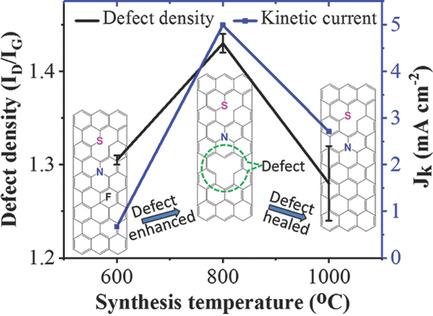当前位置:
X-MOL 学术
›
Adv. Mater. Interfaces
›
论文详情
Our official English website, www.x-mol.net, welcomes your feedback! (Note: you will need to create a separate account there.)
Doped, Defect‐Enriched Carbon Nanotubes as an Efficient Oxygen Reduction Catalyst for Anion Exchange Membrane Fuel Cells
Advanced Materials Interfaces ( IF 5.4 ) Pub Date : 2018-03-07 , DOI: 10.1002/admi.201800184 Chuyen Van Pham 1 , Benjamin Britton 2 , Thomas Böhm 1, 3 , Steven Holdcroft 2 , Simon Thiele 1, 4, 5, 6
Advanced Materials Interfaces ( IF 5.4 ) Pub Date : 2018-03-07 , DOI: 10.1002/admi.201800184 Chuyen Van Pham 1 , Benjamin Britton 2 , Thomas Böhm 1, 3 , Steven Holdcroft 2 , Simon Thiele 1, 4, 5, 6
Affiliation

|
Bond polarization of doped atoms and carbon and lattice defects are considered important aspects in the catalytic mechanisms of oxygen reduction reaction (ORR) on heteroatom‐doped carbon catalysts. Previous work on metal‐free catalysts has focused either on bond polarization or lattice defects. Here multi‐heteroatom doped defect‐enriched carbon nanotubes (MH‐DCNTs) that combine both effects to enhance ORR activity are designed. Lattice defects in MH‐DCNTs are enriched by unzipping and length‐shortening of carbon nanotubes, and also by creating carbon vacancies via decomposition of doped F atoms. Electrochemical analysis using rotating disc electrode voltammetry shows that the ORR kinetic current density of MH‐DCNT increases with lattice‐defect density, the latter of which is verified by Raman spectroscopy, while the onset potential increases with annealing temperatures. An optimized MH‐DCNT ORR catalyst exhibits a half‐wave potential of 0.81 V versus reversible hydrogen electrode and limiting current density of 5.0 mA cm−2 at an electrode rotation speed of 1600 rpm in 0.1 m KOH. Further, it is demonstrated that MH‐DCNT, as a cathode catalyst layer in an anion exchange membrane fuel cell (AEMFC), delivers a peak power density of 250 mW cm−2, which is ≈70% the performance of an AEMFC using a conventional Pt/C catalyst.
中文翻译:

掺杂的,富含缺陷的碳纳米管,作为阴离子交换膜燃料电池的高效减氧催化剂
在杂原子掺杂的碳催化剂上,氧还原反应(ORR)的催化机理中,掺杂原子的键极化以及碳和晶格缺陷被认为是重要的方面。以前有关无金属催化剂的工作主要集中在键极化或晶格缺陷上。这里设计了多种杂原子掺杂的缺陷富集碳纳米管(MH-DCNT),它们结合了两种作用来增强ORR活性。MH-DCNT中的晶格缺陷通过碳纳米管的解压缩和长度缩短以及通过掺杂的F原子的分解产生碳空位而得以丰富。使用转盘电极伏安法进行的电化学分析表明,MH-DCNT的ORR动电流密度随晶格缺陷密度的增加而增加,后者通过拉曼光谱法得到证实,而起始电位随退火温度的升高而增加。经过优化的MH-DCNT ORR催化剂相对于可逆氢电极的半波电势为0.81 V,极限电流密度为5.0 mA cm-2在0.1 m KOH中的电极转速为1600 rpm时。此外,已证明MH-DCNT作为阴离子交换膜燃料电池(AEMFC)中的阴极催化剂层,可提供250 mW cm -2的峰值功率密度,约为使用AEMFC的AEMFC性能的70%。常规的Pt / C催化剂。
更新日期:2018-03-07
中文翻译:

掺杂的,富含缺陷的碳纳米管,作为阴离子交换膜燃料电池的高效减氧催化剂
在杂原子掺杂的碳催化剂上,氧还原反应(ORR)的催化机理中,掺杂原子的键极化以及碳和晶格缺陷被认为是重要的方面。以前有关无金属催化剂的工作主要集中在键极化或晶格缺陷上。这里设计了多种杂原子掺杂的缺陷富集碳纳米管(MH-DCNT),它们结合了两种作用来增强ORR活性。MH-DCNT中的晶格缺陷通过碳纳米管的解压缩和长度缩短以及通过掺杂的F原子的分解产生碳空位而得以丰富。使用转盘电极伏安法进行的电化学分析表明,MH-DCNT的ORR动电流密度随晶格缺陷密度的增加而增加,后者通过拉曼光谱法得到证实,而起始电位随退火温度的升高而增加。经过优化的MH-DCNT ORR催化剂相对于可逆氢电极的半波电势为0.81 V,极限电流密度为5.0 mA cm-2在0.1 m KOH中的电极转速为1600 rpm时。此外,已证明MH-DCNT作为阴离子交换膜燃料电池(AEMFC)中的阴极催化剂层,可提供250 mW cm -2的峰值功率密度,约为使用AEMFC的AEMFC性能的70%。常规的Pt / C催化剂。



























 京公网安备 11010802027423号
京公网安备 11010802027423号